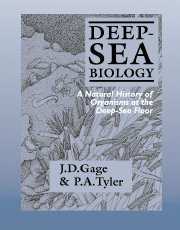Book contents
- Frontmatter
- Contents
- Preface
- Acknowledgements
- PART I The development of deep-sea biology, the physical environment and methods of study
- PART II Organisms of the deep-sea benthic boundary
- 4 The megafauna
- 5 Smaller animals
- PART III Patterns in space
- PART IV Processes: patterns in time
- PART V Parallel systems and anthropogenic effects
- References
- Species index
- Subject index
5 - Smaller animals
Published online by Cambridge University Press: 05 June 2012
- Frontmatter
- Contents
- Preface
- Acknowledgements
- PART I The development of deep-sea biology, the physical environment and methods of study
- PART II Organisms of the deep-sea benthic boundary
- 4 The megafauna
- 5 Smaller animals
- PART III Patterns in space
- PART IV Processes: patterns in time
- PART V Parallel systems and anthropogenic effects
- References
- Species index
- Subject index
Summary
These animals are usually subdivided into size-based categories (that are also reflected by peaks in size-class spectra (see Chapter 7); the meioben-thos, being defined as those animals that are retained by the finest screens down to a mesh opening of 62 microns or smaller, and the macrobenthos as that part retained by sieves with meshes of about 1 mm (Mare, 1942; Mclntyre, 1969). Those mostly single-celled organisms, such as Pro-karyotes (lacking the outer cell membranes of Eukaryotic unicells), yeastlike cells, certain sorts of Protozoans (single-celled animals, some with a quite complex organization such as ciliates) and some early stages of meiobenthic Metazoans (multicelled animals) in the size range from about 40 to 2 microns, make up an additional category, the nanobenthos (Thiel, 1983) which falls between meiofauna and bacteria.
However, the division of the benthos above nanobenthos level into size-based groupings has little ecological and even less taxonomic justification in the deep sea. This is because of a trend towards miniaturization (see Chapter 7) which has occurred to the extent that the deep sea has been termed a ‘small-organism habitat’ (Thiel, 1975). Clearly, this trend has not affected the megafauna described earlier where in some groups, such as scavenging amphipods, a reverse trend towards gigantism has occurred. However, the trend to miniaturization is well marked amongst the macrofauna (Sanders, Hessler & Hampson, 1965; Rowe & Menzel, 1971; Rowe, 1971a). Furthermore, Hessler (1974) found that he had to use a 0.3 mm screen to catch the sparse macrofauna in box-cores from the central N. Pacific, noting that individuals here are so small as to be of meiofaunal size.
- Type
- Chapter
- Information
- Deep-Sea BiologyA Natural History of Organisms at the Deep-Sea Floor, pp. 115 - 162Publisher: Cambridge University PressPrint publication year: 1991

